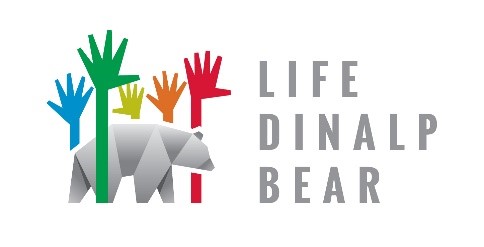Case Study
Project LIFE DINALP BEAR – Population level management and conservation of brown bears in northern Dinaric Mountains and the Alps
Contact name
Rok Černe
Institution name
Slovenia Forest Service
Region & country
Slovenia, Croatia, Italy, Austria
Summary
The project LIFE DINALP BEAR (LIFE13 NAT/SI/000550) strives to pave the way for a transition from local-scale to population-level conservation, management and monitoring of brown bears across four countries. We are using science-based solutions to establish transboundary population monitoring, reduce human-bear conflicts, develop and promote locally-based bear ecotourism, and use targeted educational activities to promote human-bear co-existence and natural expansion of the brown bear from Dinaric Mountains into the Alps. This is one of the first efforts in Europe to develop a transboundary management of a large carnivore.
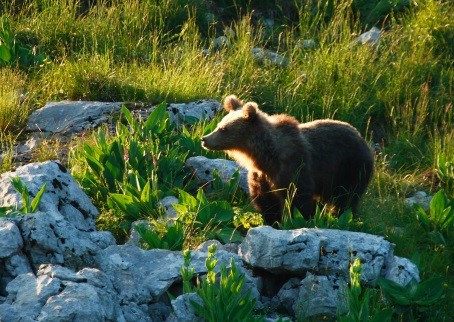
Brown bear
Photo by: Miha Krofel
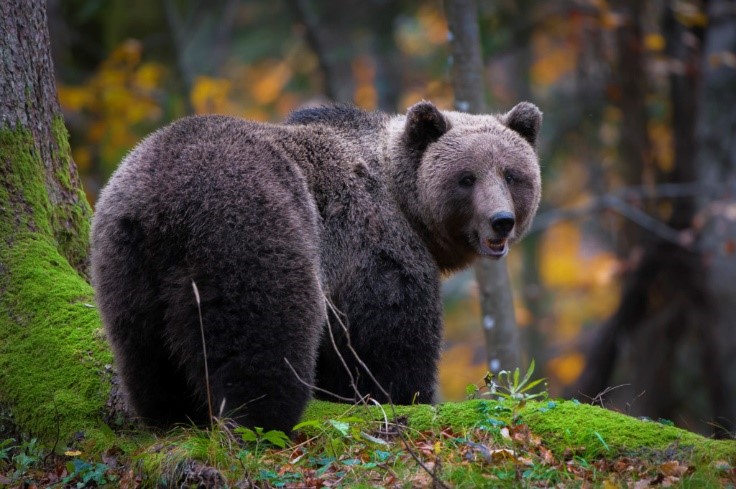
Brown bear in Slovenia
Photo by: Miran Krapež
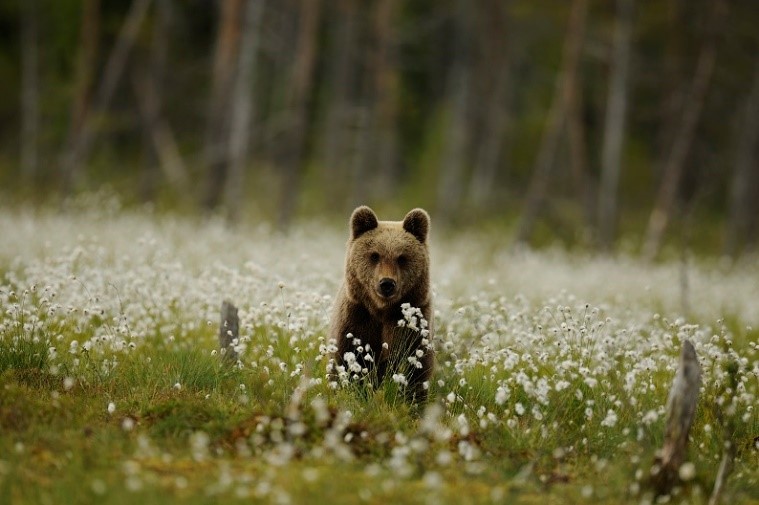
Brown bear, Italy
Photo by: Carlo Frapporti
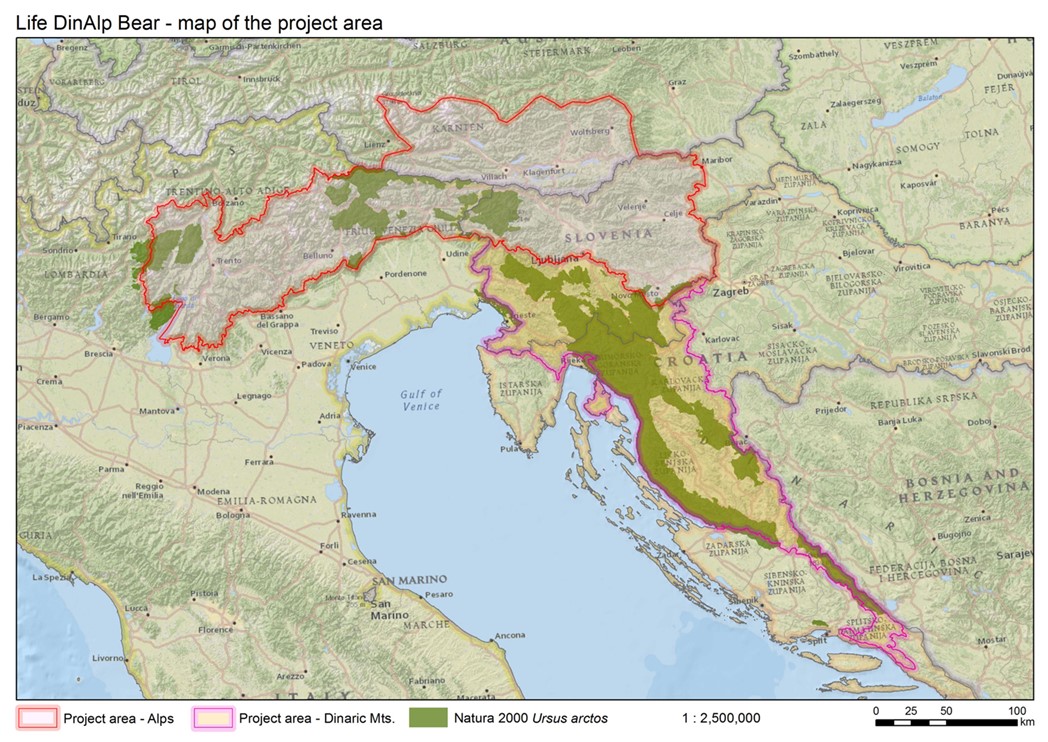
DINALP BEAR project sites location
Image by: Slovenia Forest Service
Background of the project
The north-western edge of the Dinaric brown bear population, reaching through Croatia and Slovenia, has been in previous research evaluated as an important source for the potential expansion of brown bear towards the Alps. However, the legislation and management issues that greatly differ among countries, are hampering the achievements of conservation goals on a population level. Contemporarily, public acceptance of bears in densely inhabited Europe became an ever-bigger issue, and frequent human-bear conflicts pose a serious threat to long-term conservation and coexistence with the brown bear in Europe.
It was necessary to establish common monitoring and management plans for population-level conservation. The objective is to overcome the current local-scale practices of brown bear management and pave the way for a transition to population-level conservation, management, and monitoring. The natural expansion of brown bear towards the Alps needs to be enabled, as well.
To ensure long-term conservation of brown bears we also need to decrease human-bear conflicts (thus increasing public acceptance), raise public awareness, and educate all generations and stakeholders about biological facts, scientific findings and role of bears as part of our natural heritage.
Solution and actions taken
We designed an international, interdisciplinary project that would be able to address the complex and diverse challenges of brown bear conservation in the human-dominated, politically and physically fragmented landscape of northern Dinaric Mountains and the Alps. We performed preparatory actions and elaborated common management and action plans. On this basis, we are executing concrete conservation actions and monitoring their impact. We are also raising public awareness and dedicating a lot of effort to the dissemination of results.
- Establishing population-level bear management and monitoring through cooperation of four neighboring countries for producing common management and monitoring guidelines and protocols (producing population status reports, damage cases analysis, intervention groups protocols, common monitoring methods, geo-databases,…);
- Reducing human-bear conflicts trough distributing bear-proof compost bins, bear-proof garbage bins, electric fences for livestock keeping, livestock guarding dogs;
- Decreasing bear traffic mortality with the implementation of prevention measures on roads (dynamic traffic signs, acoustic deterrents) and railway (acoustic deterrents);
- Studying the effects of carcass feeding sites;
- Training of wardens and other technicians of public bodies;
- Development of responsible bear eco-tourism and local bear-friendly products
- Improving attitude toward bears (workshops for pupils, students, scouts, stakeholders; publishing scientific, expert and popular articles, brochures, leaflets, and posters; press-releases, interviews for media; up-dating project web-page and social media profiles; establishing interactive info-points,…);
- Ensuring habitat connectivity.
Other institutions or parties involved
Project partners from four neighbouring countries (SLO, CRO, IT, AUS):
- University of Ljubljana
- Autocesta Rijeka-Zagreb d.d. (Rijeka- Zagreb Highway)
- ERICO Velenje, Ecological Research & Industrial Co-operation Ltd.
- Research Institute of Wildlife Ecology University of Veterinary Medicine, Vienna
- Veterinarski fakultet, Sveučilište u Zagrebu (University of Zagreb, Faculty of Veterinary Medicine)
- Provincia Autonoma di Trento – Servizio Foreste e Fauna (Province of Trento, Italy)
- Progetto Lince Italia
- Regione del Veneto – Unità di Progetto Caccia a Pesca (Veneto Regional Administration, Italy)
Besides, there are many other institutions, targets of project actions or external collaborators involved (environmental NGOs, schools, high-schools, naturalistic and educational societies, external experts,…).
Results
The project is still ongoing and will finish in 2019. The preparatory actions analyses and the first monitoring of the impact of project actions can be downloaded from the project website (http://dinalpbear.eu/download/).
Challenges
Our project performs in five languages (Slovenian, Croatian, Italian, German, and English), thus all project outputs need to be translated. This represents a serious challenge, especially when coordinating the project, reaching deadlines, reporting results, and confronting databases. Another challenge was the establishment of common monitoring protocols and the data pooling from diverse national databases into a single database, also due to the difficulty in comparing the data, gathered and stored with different techniques and temporal/ spatial scales. Yet another challenge was introduced by a political decision on setting up a border fencing between Slovenia and Croatia, which raised concerns in regards to wildlife movements and connectivity of populations.
Lessons learned
Large carnivores’ conservation and long-term co-existence with humans have only little to do with studying large carnivores themselves; instead, it requires almost exclusively dedicating your work to people. Public acceptance and willingness to co-exist are prerequisites for long-term conservation of large carnivores in human-dominated landscapes.
